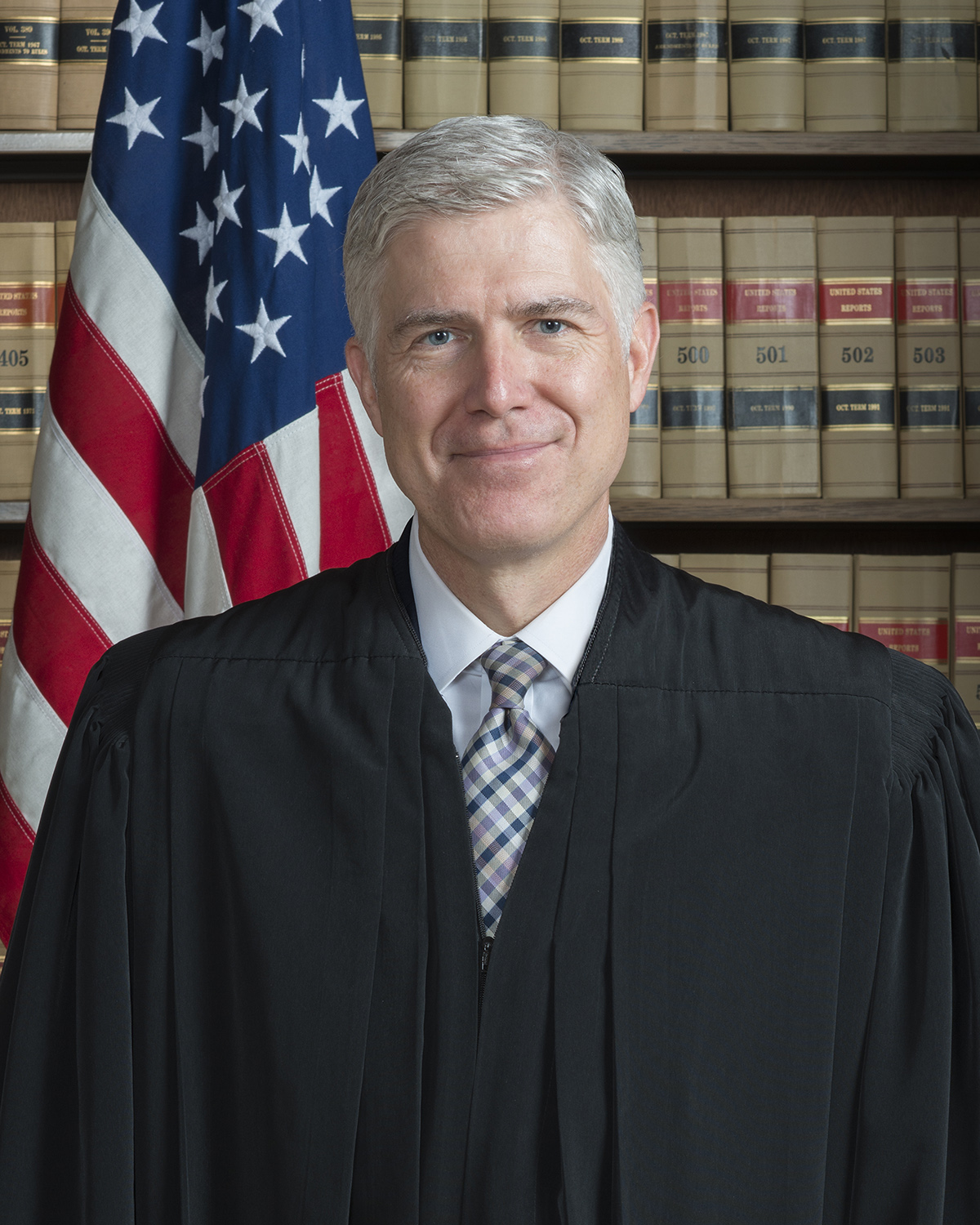“Gorsuch’s dissent in Thryv draws together key threads of his judicial philosophy, and in particular his concern for separation of powers and protection of courts’ Article III authority.”
In an energetic dissent in Thryv, Inc. v. Click-to-Call Tech., LP, 590 U.S. __ (Apr. 20, 2020), U.S. Supreme Court Justice Neil Gorsuch provides a compelling defense of patent rights, and he champions a patent owner’s ability to obtain judicial review of certain threshold administrative decisions from the Patent Trial and Appeal Board (PTAB). But while Justice Gorsuch’s insightful analysis is receiving accolades from many in the patent community, it failed to garner any support among his Supreme Court colleagues, save for one, Justice Sotomayor.
The Recap

Associate Justice Neil M. Gorsuch; photograph by Franz Jantzen, 2017.
As previously reported on IPWatchdog, in the proceedings leading up to this recent decision, Click-to-Call sued Thryv for patent infringement. As is common in such litigation, Thryv filed an inter partes review (IPR) petition with the PTAB, challenging the patentability of Click-to-Call’s patent. Click-to-Call responded to the petition by arguing, in part, that a previous lawsuit between the parties more than a year earlier precluded the IPR petition under 35 U.S.C. § 315(b), the so-called “one-year time bar”. In its Institution Decision, the panel of three Administrative Patent Judges (“APJs”) disagreed with Click-to-Call, finding that the previous litigation had been dismissed “without prejudice”, and thus did not trigger Section 315(b)’s time bar. In its Final Written Decision at the conclusion of the IPR proceeding, the same 3-APJ panel found that Thryv had successfully proven that Click-to-Call’s patent was unpatentable (?invalid) in view of Thryv’s asserted prior art. The panel also reiterated that the IPR proceeding was not time barred under Section 315(b).
Click-to-Call appealed the PTAB’s decision to the U.S. Court of Appeals for the Federal Circuit. With respect to the Section 315(b) time bar issue, Thryv argued that 35 U.S.C. § 314(d) prohibited the Federal Circuit from reviewing the PTAB’s threshold decision to institute the IPR proceeding, including the PTAB’s interpretation of Section 315(b). The Federal Circuit (ultimately sitting en banc) disagreed, determining that Section 314(d) only prohibited the Court’s review of issues closely related to patentability, and not to issues ancillary to patentability, such as the proper interpretation of Section 315(b)’s time bar. The Federal Circuit thus proceeded to interpret Section 315(b) as a question of law, and decided that the parties’ dismissal “without prejudice” of the previous lawsuit did not avoid the one-year time bar. Thus, because Thryv’s belated petition violated the statutory bar, the Federal Circuit reversed the PTAB, thereby saving Click-to-Call’s patent.
Thryv then appealed to the Supreme Court. Interestingly, at this stage of the litigation, on the substantive merits of patentability, the parties did not dispute that Click-to-Call’s patent was invalid. But reciprocally, on the procedural merits of the one-year time bar, the government (i.e., the DOJ supporting Thryv) did not dispute that the IPR proceeding should have been prohibited under Section 315(b), the PTAB’s contrary decision notwithstanding. Thus, the key issue for the Court to resolve was whether Section 314(d) prohibited Article III courts from any review of the Article I agency’s decision on the statutory time bar issue.
Majority Focuses on “Bad Patents”
The majority opinion, drafted by Justice Ginsburg, answered this question with an emphatic “Yes!” Quoting the Court’s decision in Cuozzo Speed Techs., LLC v. Lee, 579 U. S. __, __ (2016), the majority reasoned that “§314(d) bars review at least of matters ‘closely tied to the application and interpretation of statutes related to’ the institution decision . . . .” The majority then concluded that “a §315(b) challenge easily meets that measurement.”
Part III-C of the majority opinion (interestingly not joined by Justices Thomas and Alito) will undoubtedly be cited by patent litigants and commentators for years to come. There, the Court characterizes, then consults, the purpose of the America Invents Act for interpretive guidance: “Congress, concerned about overpatenting and its diminishment of competition, sought to weed out bad patent claims efficiently.” Indeed, the Court interjects the term “bad patent” three times in this part of its opinion. Perhaps most revealing of the Court’s sentiments and underlying rationale is the following somewhat disquieting passage:
The agency held Click-to-Call’s patent claims invalid, and Click-to-Call does not contest that holding. It resists only the agency’s institution decision, mindful that if the institution decision is reversed, then the agency’s work will be undone and the canceled patent claims resurrected.
Gorsuch Warns of Erosion of Article III Courts
In dissent, Justice Gorsuch begins his multi-faceted critique of the majority decision by warning that it “permits a politically guided agency to revoke an inventor’s property right in an issued patent” and “allow[s] the agency’s decision to stand immune from judicial review.” But, for Justice Gorsuch, more is at stake than merely the availability of judicial review of the PTAB’s time-bar rulings. To him, Thryv is a harbinger of the erosion of the separation of powers, and in particular, of the courts’ power under Article III of the Constitution. He lays down this marker early in his dissent, echoing Chief Justice Marshall’s famous declaration in Marbury v. Madison, 5 U.S. 137, 177 (1803) (“It is emphatically the province and duty of the judicial department to say what the law is”) when he characterizes Thryv’s argument as an “insist[ence] that Article III courts lack authority even to say what the law demands.”
In a methodical and hierarchical sequence, Gorsuch employs a series of judicial tools of statutory interpretation. He starts with the statutory text (Part II-A), something (as he has explained in his recent book) he strongly favors. See Gorsuch, A Republic, If You Can Keep It (“A Republic”) at 128-134. Then he moves to broad context and policy arguments (Part II-B), something he generally disfavors, see A Republic at 138, but which here he finds to be neutralized by equally persuasive countervailing arguments. Next in Part III, he focuses at some length on the judicial presumption favoring judicial review, established by longstanding precedents. Toward the end of this analysis, he further rejects Thryv’s arguments from statutory purpose – a form of argument that he has forcefully rejected. See A Republic at 137-142. Perhaps risking protesting too much, though, Gorsuch contrasts several interpretive tools: “The historic presumption of judicial review has never before folded before a couple stray pieces of legislative history and naked policy appeals.” Of course, “historic” doctrines will always win out over “a couple stray” items and “naked” arguments. Gorsuch concludes with an argument that the precedent relied on by Thryv is mere dicta (Part IV), and a call to overturn Oil States (Part V) – the latter being a theme he covered at length, along with the separation-of-powers themes that frame his dissent, in A Republic at 38-74. In sum, Gorsuch’s dissent in Thryv draws together key threads of his judicial philosophy, and in particular his concern for separation of powers and protection of courts’ Article III authority.
A Dire Prediction
Gorsuch’s ominous conclusions will undoubtedly raise the alarm for many in the patent community:
[T]he Court . . . carries us another step down the road of ceding core judicial powers to agency officials and leaving the disposition of private rights and liberties to bureaucratic mercy. . . . Inventors like Mr. DuVal just have to hope that the bureaucracy revoking their property rights will take the extra trouble of doing so in accordance with law.
Whether Gorsuch’s dire predictions will come to pass remains to be seen.

![[IPWatchdog Logo]](https://ipwatchdog.com/wp-content/themes/IPWatchdog%20-%202023/assets/images/temp/logo-small@2x.png)


![[Advertisement]](https://ipwatchdog.com/wp-content/uploads/2024/04/Patent-Litigation-Masters-2024-sidebar-early-bird-ends-Apr-21-last-chance-700x500-1.jpg)

![[Advertisement]](https://ipwatchdog.com/wp-content/uploads/2021/12/WEBINAR-336-x-280-px.png)
![[Advertisement]](https://ipwatchdog.com/wp-content/uploads/2021/12/2021-Patent-Practice-on-Demand-recorded-Feb-2021-336-x-280.jpg)
![[Advertisement]](https://ipwatchdog.com/wp-content/uploads/2021/12/Ad-4-The-Invent-Patent-System™.png)







Join the Discussion
10 comments so far.
Pro Say
April 24, 2020 02:43 pmWhen you’ve got friends like SCOTUS . . . who needs patent enemies?
And an excellent point about the option of looking to a reexam, G.K. @ 2.
Robert Greenspoon
April 24, 2020 09:33 amYesterday (April 23), the Supreme Court called for a response to our client’s petition in Chrimar v. ALE USA, just one day after the Court distributed the petition and three amicus briefs for conference. ALE’s response is due May 26. This is on topic. Justice Gorsuch’s Thryv dissent attached the same Fresenius line of Federal Circuit cases that our petition attacks.
AAA JJ
April 24, 2020 08:38 amI’m not sure J. Gorsuch’s concern is so much “patent rights” as it is the constitutional issues those “patent rights” raise in the context of this case. I agree with his dissent, but the damage has been done by the majority. A legislative fix is probably the only hope. And I’m very skeptical of that happening (unfortunately).
Bruce Linley
April 23, 2020 11:45 pmNew inventors already know patent rights have been dead a long time ago. What kind of bazaar world are these judges living in. The AIA Act the PTAB, 101 and EBay,Mayo and Alice ruling have completely destroyed all patent rights in the United State of America. America has let a few Tech companies dominate while it kills of and forces new inventors to looks else where like Europe and Asia to find Angel investors and patent protection. Globalization will not kill America its there own rules that will. They say greed will eat it self and America is proving that term to be 100% accurate. Good by America
Bart
April 23, 2020 08:55 pm“The Court characterizes, then consults, the purpose of the America Invents Act for interpretive guidance: ‘Congress, concerned about overpatenting and its diminishment of competition, sought to weed out bad patent claims efficiently.'”
Pardon my French, but this is f*ng b*11 schite, direct from the mouth of Ginsberg and SCOTUS.
The American Invents Act says THIS as its purpose:
“It is the sense of Congress that the patent system should promote industries to continue to develop new technologies that spur growth and create jobs across the country which includes protecting the rights of small businesses and inventors from predatory behavior that could result in the cutting off of innovation.”
THAT, SCOTUS mf*kers, is the purpose of the AIA. It is NOT about ‘bad patents’. It is about PROMOTING INDUSTRY. And includes what? Includes PROTECTING THE RIGHTS OF SMALL BUSINESSES AND INVENTORS from PREDATORY BEHAVIOR.
It has nothing to do with bad patents, but everything to do with bad behavior. Such behavior includes efficient infringement that destroys the rights of small businesses and inventors.
Read the ef’in bill.
anonymous
April 23, 2020 07:56 pmGorsuch is exactly right on this one. His dissent provides more context concerning the background of the dispute and is worth reading. The majority is going down a very dangerous path here.
Ternary
April 23, 2020 11:51 amOne question keeps on coming back to me: “do people believe that a bad patent represents a bad invention?” And is the expectation that denying “bad patents” (whatever these mythical documents are) will stop inventors doing bad inventions? One thing seems clear: the continuing stomping on rights of independent inventors will leave only the most dedicated to pursue this rather unfruitful goal of doing an invention to start a business. The field will thus be left to the “deserving operators.” You know, the ones who got first in line to plunder the funds of the Payroll Protection Program.
Justice Gorsuch clearly understands the original intent of the Framers to bestow property rights on inventions. It is not hard to find the reasons why the Framers did this. People in the general population knew very little at the time of our Independence. Really, very little. Enlightenment promised (and did) change that. Now, as we think we know “a lot,” many people believed a patent system is unneeded. Well, nothing like a crisis like the current one to bring us back to reality.
I am sure we need independent inventors, the much touted American ingenuity, to help in rebuilding the economy. Giving away money, as promoted by our institutions, seems to be iffy as we are unable to get it in time to the people who need it most. The system has become so incredibly self-dealing that novel initiatives (the life blood of the American economy) have become hard if not impossible.
One of the easiest thing Congress can do to help re-start our economy is to help American entrepreneurs in obtaining affordable, rational and valid patents to start and grow their businesses. Congress, don’t leave this to the Courts.
EG
April 23, 2020 09:35 amGorsuch is the ONLY SCOTUS Justice I still respect. He gets the point that patents are “property” that are subject to Fifth Amendment “due process” protections, including the right to appeal to the courts when PTAB oversteps. That the other SCOTUS Justices don’t by simply mouthing the “bad patents” false narrative is as scandalous as it is duplicitous.
G.Kapsalas
April 23, 2020 07:59 amIt would seem that Majority’s concern with undoing Agency’s work and reinstating an invalid patent (“bad” in the opinion’s terms) could have been significantly mitigated had Click-to-Call’s approach emphasized that other appropriate procedural avenues such as classic reexamination remained open and would/should remain open were the CAFC decision to be upheld, so that in the end an equitable outcome satisfying underlying policy objectives in a manner compliant with lower decision and preserving judicial review could be obtained. In summary, “send-it-back-for-reexamination.” That might have been less eventful on our ever-active precedent stage, perhaps mercifully so.
Anon
April 22, 2020 06:07 pm“Whether Gorsuch’s dire predictions will come to pass remains to be seen”
Wrong.
We ARE already seeing it.